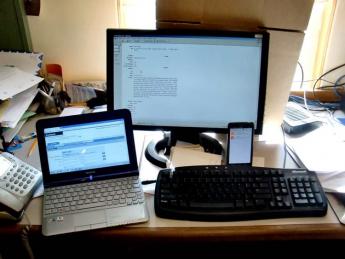Antiquarian Booksellers' Association of America Ten Pound Island Book Company
Computers, or: the tough life of an antiquarian bookseller, part 1 and 2

By Greg Gibson
Part 1 - Request for Proposal (February 16, 2014)
I operate an antiquarian book business. I sell rare books and ephemera at book shows, and through email and telephone quotes to retail customers, institutions, and other dealers. I publish a weekly blog with rare items featured. I post occasionally on Facebook and Twitter. I list books on two Internet listing services, and I publish catalogs online, through my website -http://tenpound.com/ - as well as occasional hard copy catalogs which I design and send to a commercial printer. The website is fairly basic HTML, or so I am told. My son manages it for me, but I would like to start doing this myself.
For the past eight years I have used a locally built computer to accomplish such tasks as cataloging my inventory, keeping track of my customers, managing invoices, sending and receiving emails, creating virtual and hardcopy catalogs, and posting to various websites. I use an ancient iteration of Filemaker Pro operating a very basic database with lookup features that I designed myself in the late 1980s when I had a brain. I use Microsoft Word 2000 for word processing, a five year old version of “Art Explosion Publisher Pro” for laying out PDF catalogs to be published on the Internet or to send to the printer, Photoshop 6.0 for processing images, and Outlook Express for email. When I am on the road I use a rather unsatisfactory web mail program provided by Peak Web Designs. Also a scanner and printer, of course.
Now my computer is mortally ill, and it is time to replace this ancient but functional system that I have cobbled together. Understanding that my current software will not be supported by a new computer, my goals are as follows:
Generic low priced PC capable of accomplishing my simple requirements.
Updated iterations of Filemaker, Word, and programs that are supported by the new operating system of choice (I’m currently on Windows XP - soon to be history, I know), and that serve the functions of Photoshop and Publisher Pro, but are simpler to operate (I only need these programs to do a few simple things and have no interest in bells and whistles.)
Seamless transfer of data into new iterations of software with similar or improved functionality.
An email program to replace Outlook Express, with continued access to archived emails.
A means of accessing my desktop while I’m on the road.
A device, other than my low-brained Toshiba Netbook (circa 2010) that will allow me to access my desktop from the road and let me work as if I were in my office.
Training to accomplish these goals (including managing my own website), and advice on how to simplify them. I have no interest in computers and communications technology other than how to use them to sell what I have to sell. So I would also welcome advice on how to streamline what I am presently doing, with enhanced ease of use.
If you are interested in helping me, please send me a proposal stating the means by which you will accomplish my goals, the cost, and a time frame, including a start date.
Part 2 - Making Do (February 23, 2014)
My new computer is scheduled to arrive sometime next week. Maybe. Meanwhile I’ve been making do.
The big screen in the illustration above is the monitor for my mortally ill computer, which can only run filemaker. So I catalog my books on that one, but slowly, or it’ll freeze up. The little netbook is my Internet access – google, OCLC, ViaLibri and the like – also done slowly, since it’s only got 2 megs of ram. (Just by way of comparison, my new machine will be delivered with 8 gigsof ram.) And the droid, of course, is for quick emails, texting, and other attempts to reach out from computer hell.
So, to quote material to customers I take the item to be quoted from the big screen, and transfer it onto a flash drive (praying that the computer will not die in the midst of this taxing operation), then I copy the info from the flash drive onto my little computer and manually copy the email address of the person to whom I’m quoting the item from the big computer. Then I email the description. Sorry, no images until the new machine arrives.
As you can imagine, this is a very tedious operation. Mostly, I’ve been confining my cataloging to more expensive items that require careful study and research. That way, I only have to poke my poor computer back into life two or three times a day.
Here’s an item I just cataloged. I especially like it because it illustrates how “history” changes depending on who is writing it.
Manuscript. LOG OF THE EMILY ST. PIERRE, LIVERPOOL TO CALCUTTA, W. WILSON COMMANDER, 1861.
Folio, unpaginated. About 350 partially printed pages accomplished in manuscript. This long-forgotten incident was big news in its day, and a major embarrassment to the American government and the Union Navy. The Emily St. Pierre was an 884 ton bark built in Bath, Maine in 1854, and owned by the British firm Fraser, Trenholm and Co. On the voyage in question, she sailed from Liverpool to Calcutta, then back to the US, calling at Charleston on her way to St. John,New Brunswick. She departed Liverpool May 20 and arrived in Calcutta on September 11. The log, kept by the captain of the Emily St. Pierre, details the voyage toCalcutta. It gives names of crew members on daily watches, position, weather, ships sighted, sails set, and incidents aboard - such as the fight that broke out on deck shortly after their arrival in Calcutta. They discharged cargo until October 19, and took on “government ballast,” “dunnage wood,” and bales of gunny cloth and mats. On November 26 Captain Wilson noted, “total number of bales received 2173.” On November 28 they departedCalcutta (the captain kept a careful record of the way up and down the river). On March 19, 1862, as they approached Charleston they were boarded by a prize crew from the Union steamer James Adger. The crew was put aboard the USS Florida, all except for the steward, the cook, and Captain Wilson, the only man familiar with the workings of the Emily. They were accused of smuggling saltpeter and war supplies for the Confederacy. Wilson“told them that thinking the port might be open I had called at to see and if blockaded I was going to St. Johns.” After the ship was taken over, there are two days of log entries in the prize master’s hand. Then, in Wilson's hand, “7 am Recaptured the ship from Prize Capt and his crew.” This is followed by about 200 words written by Captain Wilson, telling how he enlisted the steward and the cook to help him overpower the Union captain and prize crew, how one man resisted and was shot, and how the prize crew were temporarily imprisoned in staterooms. Then, realizing he needed their help to sail the ship, Captain Wilson convinced the prize crew to help. After a harrowing voyage they arrived in Liverpool on September 21, whereWilson became the toast of the town. There are several contemporary newspaper accounts, available through Google, which add to the story. American sources uniformly insist the Emily St. Pierre was a blockade runner. Indeed, Wilson says that the prize captain from the James Adger had orders to seize his ship even before examining his papers and cargo for contraband. In its listing for the James Adger, the Dictionary of American Naval Fighting Ships makes no mention of this embarrassing recapture, saying only that the Emily was captured “attempting to slip into Charleston with a cargo of 2173 bales of gunny cloth sorely needed for baling cotton.” English sources claim that the Emily St. Pierrewas a merchant ship. Wilson himself makes no mention, then or later, of his intention to run the blockade. It is interesting to note, however, that after this episode he commanded several known blockade runners. This is the captain’s own log, and the accounts of the voyage, the capture and the re-capture are entirely his own. As such, it is a unique piece of naval history.
Next week - back to more bookish matters - I hope!
(Posted on Bookman’s Log, February 16, and on Bookman’s Log, February 23. Presented here by permission of the author.)

